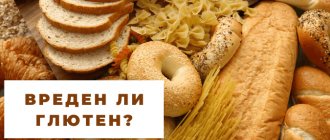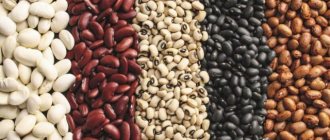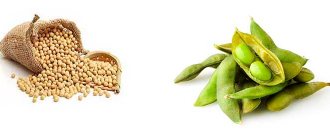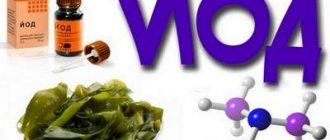Every person's diet should contain fats. Thanks to these substances, the body absorbs vitamins much more easily and tolerates hypothermia and damage much more easily. Fats are also a source of energy.
There are the following types of fats: saturated, unsaturated and trans fats, which are also called hydrogenated.
Trans fats contain trans isomers, or elements of unsaturated fatty acids. Consuming such substances in large quantities can harm the body. Exceeding the permissible daily allowance by just 2% increases the risk of developing cardiovascular diseases by 25%.
Trans fats are produced through hydrogenation. The essence of the process is that hydrogen is passed through vegetable oil heated from +200 to 1000°C. The process also uses a powder catalyst. As a result of this effect, some unsaturated fatty acids become saturated. The mass becomes solid and resistant to oxidation processes.
This process makes it possible to obtain fat mass for the production of margarine, soap, cooking, frying and confectionery fats. The main advantages of such substances are low cost and long shelf life.
Good quality solid fat has a high price and requires high production costs. Liquid fats of vegetable origin have low nutritional value and quickly become unusable. In order to make the production process quick and cheap, vegetable oils are hydrogenated.
Natural foods may also contain trans fats. This primarily applies to milk and meat fat. Such substances are formed in the body of animals, and differ in composition from artificial ones. Consumption of animal products in normal quantities does not cause harm to the human body.
Trans fats - what are they and in what foods are they present?
This is a separate class of saturated fats, which is widely used in the food industry and catering establishments. Despite the fact that people have no need for this component at all, it is highly popular. This is due to the following reasons:
- long shelf life;
- convenient consistency;
- cheapness;
- versatility - spreads are used for baking and frying, for spicy snacks and desserts;
- contribute to the creation of an appetizing appearance of the finished dish.
This culinary additive, which has proven itself as a convenient ingredient, is obtained from liquid vegetable oils through chemical processing. It's called hydrogenation, the essence of the process is to make fatty acids (from cottonseed, sunflower, soybean or other oils) saturated, that is, solid. To achieve the required reaction, a temperature of about 200 degrees, the supply of hydrogen under pressure and the presence of catalysts are needed - they are usually copper-nickel salts.

Nutritionist's comment:
It should be noted that trans fats also include some natural fats that are part of the meat of herbivores. Also, during frying, a small part of the oil takes on the structure of trans fat. But it is still correct to consider this substance a product of the chemical industry, since it is from these enterprises that it enters our food in such quantities that can affect health and well-being. Natural analogues are contained in such a small proportion that they have no effect.
Legislative regulation of the use of trans fats in the food industry: experience of other countries
USA
In 2015, the FDA announced that it had adopted a program to completely eliminate artificial trans fats from foods sold in the US market. This step became a way to globally prevent the thousands of deaths from heart attacks and heart attacks that are recorded every year.
FDA research states that PHOs, partially hydrogenated oils, a major trans fat that is not generally recognized as hazardous, cannot be used in products after June 18, 2021, unless otherwise approved by the FDA. For reference: PHOs are formed in the hydrogenation of fats, which makes them resistant to oxidation.
Thus, product manufacturers were given a 3-year grace period to completely remove PHOs from their products. During this period, manufacturers must either reformulate their products or obtain approval for the use of specific PHOs in the food industry. Large companies that value their reputation have already taken appropriate measures and voluntarily replaced PHOs with safe fats or oils. Of course, small amounts of trans fat can be produced during processing of foods such as meat and milk. But deliberate introduction of them into the product will be prohibited.
It is worth saying that the FDA began paying attention to this problem back in 2006. It was then that a mandatory condition was approved to indicate trans fats as a percentage on the label in the list of ingredients. This requirement has already led to a decrease in their quantity in products. However, they are still used in food products, especially in icing, cream, coffee, popcorn, and baked goods.
In April 2021, Yale University School of Medicine researchers published a fresh study in the Journal of the American Medical Association (JAMA Cardiology). The work used data from the New York Department of Health. There was a 6.2% decrease in hospitalizations for stroke and myocardial infarction among residents of countries with restrictions on trans fatty acids compared to countries where these restrictions have not yet been introduced. This good and significant result was achieved in just 3 years, which means that the figure will increase in the future.
Finland
Finnish producers have long switched to a healthy diet position. More than 20 years ago, almost all meat sold in the country began to be sold without fat. Such “lean” meat is obtained in a fairly simple and obvious way - simply by cutting off the fat. The result is obvious: the number of cardiovascular diseases has decreased by 25%. The level of trans-isomers of fatty acids in products is also regulated at the legislative level.
- Denmark. In 2003, a ban was introduced on foods produced in Denmark containing more than 2% trans fatty acids.
- Austria. Restrictions similar to the Danish ones were officially introduced in 2009.
- Hungary and Norway. Restrictions on the content of trans fats of no more than 2% have been introduced since 2014.
- Australia. Since 2003, the country has produced most butters and margarines with minimal levels of trans fats.
- Switzerland. In 2010, restrictions were introduced on the use of trans isomers.
EU
- Since 1995, decisions have been made to reduce trans fatty acids in foods in many European Union countries;
- At the moment, the content of trans fats in products produced in EU countries is regulated by a maximum permissible level of no more than 2%.
Today, the development of policy measures to completely eliminate trans fats from food is one of the main objectives of the European Food and Nutrition Action Plan 2015–2020.
Content in food
When they talk about the need to exclude fats from the menu, rest assured that they are talking about a component such as trans fats; other lipids are not harmful when consumed in moderation. Although they were not developed at all in order to become the sworn enemy of nutritionists and adherents of a healthy lifestyle.
At the beginning of the 20th century, soybeans began to be actively grown, which were highly valued for their large amount of protein. Farmers' fields were taken over by a low-maintenance crop that could feed many people on a modest budget. As a result of this boom, a large by-product emerged: soybean oil. Hydrogenation made it possible to transform it from a useless raw material into a valuable alternative to pork fat, which was not enough for everyone. This is how margarine appeared. It was very actively consumed as food, without realizing the negative impact for a long time. Only at the end of the 20th century did doctors come to the conclusion that such a component had a very detrimental effect on the functioning of many organs and systems.
Industrial process for hydrogenation of trans fats
To obtain a cheaper product for use in cooking, an innovative technology for hydrogenating vegetable fats to produce trans fat was developed.
Vegetable oils were used for this technology:
- Refined sunflower oil,
- Palm oil,
- Coconut oil,
- Cotton oil
- Soybean oil.
Hydrogenation of vegetable oils made it possible to transform their consistency from a liquid state into a fairly solid product.
This process is divided into several stages:
- Purification (refining) of vegetable oil from all kinds of impurities in it,
- Due to copper and nickel salts, fats are saturated with hydrogen atoms,
- After fatty acids combine with hydrogen atoms, the vegetable oil molecules harden and transgenic fat is obtained,
- There is also a dehydrogenation technique, when the process of detaching hydrogen atoms from fatty acid molecules occurs and a transition from the solid structure of trans fat to the liquid structure of oil occurs.
At the everyday level, a person does not need to know the process of producing trans fats, but every person who cares about their health and the health of their family should study the labels on them when purchasing products.
Over the past few decades, global consumer protection policies have required all food manufacturers to indicate on their food labels the presence of saturated fats and hydrogenated fats, which are hazardous to the human body.
European and American manufacturers strictly adhere to these rules, but manufacturers in Russia and countries from the post-Soviet space are not always conscientious in complying with all the requirements and laws of their state and the international community.
Hydrogenation of vegetable oils made it possible to transform their consistency from a liquid state into a fairly solid product
Why are trans fats dangerous?
There are components used in the cosmetics and food industries, the negative effects of which are not convincingly proven. However, they are banned in many prosperous countries. An example would be pesticides or parabens. Hydrogenated fats can cause much more serious damage, but this did not cause a ban on their use in Russia. On store shelves and in fast food outlets you can easily buy products with a high margarine content.
There is plenty of convincing evidence regarding the harm of trans fats to the human body; this is not a debatable issue. Here are a few facts about how they affect you.
Disorders of the cardiovascular system
Hydrogenated fats contribute to an increase in the level of “bad” cholesterol, and, on the contrary, there is less “good” cholesterol. This leads to the formation of cholesterol plaques on the inner walls of blood vessels and narrowing of their lumen. Subsequently, under such conditions, many serious diseases can develop that reduce the quality of life and can cause death.
Nutritionist's comment:
It is not recommended to eat foods that contain trans fats due to an increased risk of thrombosis. Lipids with this structure interfere with the normal synthesis of prostacyclin, which causes the formation of blood clots. On the contrary, the production of thromboxane increases excessively, which contributes to blood thickening.

Brain dysfunction and multiple sclerosis
Modified fats are incorporated into brain cells, displacing the necessary docosahexaenoic acid, which reduces their susceptibility to nerve impulses. Instead of proper nutrition, the epithelium receives a synthetic analogue, which is not capable of performing important functions. This negatively affects mental processes, memory, and the ability to concentrate. There is a risk of developing senile dementia.
This is the basis for the hypothesis that excessive consumption of confectionery products containing trans fats in childhood leads to the development of atherosclerosis in the future. This is due to the fact that modified molecules are integrated into the nervous tissue, displacing Omega-3 lipids from cell membranes. The researchers concluded that there is a direct connection with diet.
Premature aging
Every time we eat baked goods with margarine, we bring our old age closer. This is due to oxidative stress, which occurs due to the presence of dehydrated fats in the body. At such moments, a critical amount of free radicals is formed, which negatively affects both health and the appearance of the body.
If you want to prolong youth, then your diet should be dominated by foods that do not contain trans fats, but antioxidants - these are fresh fruits and berries, dried fruits, ginger, green tea.
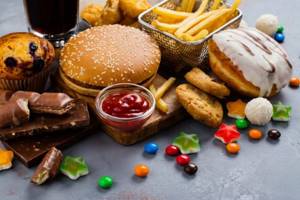
Comedones, areas of inflammation on the skin
Another consequence of poor nutrition is clogged pores, dull complexion, increased sebum viscosity, decreased local immunity and vulnerability to bacteria. If inflamed elements regularly appear on your face and there are a lot of blackheads and milia, then it’s time to reconsider your diet and give up saturated fats in favor of unsaturated fats, and also enrich the menu with fresh vegetables and fruits.
Obesity
Excess body weight is also a consequence of eating fatty, unhealthy foods. Typically, trans fats are found in sweets, fast food and snacks that are generously flavored with flavor enhancers and sugar. Such food cannot in any way ensure a slim figure for your figure, as the following processes occur:
- control over appetite is completely lost - you constantly want to eat;
- high-calorie foods do not allow you to meet your normal daily caloric intake;
- the so-called “insulin circle” is triggered, in which a lot of insulin is released into the blood due to the high glycemic index of the foods consumed, and as a result, a feeling of hunger quickly sets in.
If you decide to lose excess weight for a long time, then snacks and sweets with a significant content of trans-isomers must be excluded from your diet.

Diabetes mellitus type 2
Hydrogenated fats lead to a decrease in the sensitivity of pancreatic cells to insulin, and there is also a violation of the biochemistry of inflammatory processes. Products from the list containing trans fats affect metabolism, provoking serious pathological changes. Such consequences may not occur soon, but the harmful effects have been proven. Don’t wait until your health and figure begin to deteriorate; give up junk food today.
Where are trans fats found?
These are isomers of trans products of polyunsaturated fatty acids, which are formed in normal molecules found in vegetable oils.
Hydrogenated fat is found in small quantities in natural vegetable oils, as well as in bacteria that inhabit the stomach of ruminants, so trans fats are found in small quantities in milk and, accordingly, in cow butter, containing from 2.0% to 8.0% hydrogenated oils .
And hydrogenated oil, which was obtained industrially, contains tan fats from 67.0% to 70.0%.
It is also necessary to note the fact that trans fats, which have a natural basis, and trans fats, which have an artificial way of obtaining this product, contain completely different structures, and, accordingly, different properties of their influence on the human body.
Hydrogenated oil
Where can trans isomers be found?
Current legislation recommends that manufacturers indicate the presence of trans fats in products, but does not oblige them. Therefore, studying the label is not always 100% informative. We offer a visual table of which food products are most likely to contain trans fats:

On the packaging, such fat may be called cooking fat, hydrogenated fat, modified vegetable fat, or margarine. Even if chemically treated lipids are not used in the production of the listed delicacies, you will not lose anything by refusing them. Such delicacies will not lead to a beautiful figure. If you want to get rid of extra pounds, replace cakes, sweets and chips with healthy foods.
How to avoid the harm of trans fats
To make sure you don't harm yourself, read the labels. Do not consume products that contain the words margarine, specially prepared vegetable oils, "hydrogenated fats" or "partially hydrogenated" in the ingredient list.
Unfortunately, reading labels is not enough in all cases. Some processed foods (such as regular vegetable oils) may contain trans fats without being listed on the label or ingredient list.
To avoid these substances, the best thing you can do is remove processed foods from your diet.
Choose real butter instead of margarine, and olive oil or coconut oil instead of refined vegetable oils... and make time for homemade meals instead of fast food
.
How to recognize by eye
If it is not possible to examine the packaging - you are being treated to a dish at a holiday or picnic - you can determine the presence of hydrogenated lipids by the following signs:
- food does not spread, maintaining a solid or semi-solid consistency even at room temperature;
- perfect golden roasting - due to the high smoke point of trans fats, unlike other saturated fats, products after intensive heat treatment do not have any traces of burning;
- A briquette of butter that you just took out of the refrigerator is cut plastically in the absence of modified additives, pieces would break off from it.
But it’s still better to rely on the information on the packaging. Try to make reading the label a mandatory ritual before every purchase.
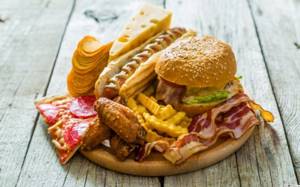
List of major foods with trans fats
According to the Technical Regulations of the Customs Union of 2013, the packaging of a fatty product with the permissible use of modified oils must contain information about the maximum content of trans fatty acids when exceeding 0.9%.
Not every manufacturer fulfills this requirement. In the composition indicated on the product packaging, the content of trans isomers may be hidden under the following names:
- margarine;
- vegetable oil;
- vegetable, cooking, confectionery fat;
- cocoa butter substitute or equivalent;
- hydrogenated oil;
- vegetable cream;
- milk fat substitute.
There are practically no artificial trans fats in oil refined and purified by freezing.
Federal law limits the content of trans isomers in the following products:
- soft margarine;
- baked mixtures;
- cocoa butter substitutes, equivalents and improvers;
- spread
From January 1, 2021, the recommended maximum permissible percentage of trans isomers in the fat of such products is 2%.
In other products the quantity is not standardized.
Content of trans isomers
Table listing major foods that contain trans fats:
| Product | Trans isomers, % |
| Crude rapeseed oil | 0. 1–0. 3 |
| Refined rapeseed oil | ≤ 1. 0 |
| Beef fat | 2. 0–6. 0 |
| Lactic | 2. 3–8. 6 |
| Soft margarine | 0. 1–17. 0 |
| Cooking fat | 18. 0–46. 0 |
| Margarine for baking | 20. 0–40. 0 |
| Bulk margarine | 25. 0–48. 0 |
| Hydrogenated rapeseed oil | 57. 0–67. 0 |
List of products based on hydrogenated fats:
| Name | Fat content,% | Trans isomers, % of fat |
| Bakery products | 1. 4–8. 7 | 0. 25–17. 35 |
| Potato chips | 10. 2–18. 0 | 2. 9–34. 8 |
| Mixes for quick breakfasts and lunches | 15. 3–26. 0 | 0. 48–38. 63 |
| Table margarine | 62. 8–80. 0 | 0. 13–15. 8 |
| Cooking fats | 80. 0–99. 0 | 0. 42–21. 27 |
| Confectionery and bakery shops | 80. 0–99. 0 | 1. 12–6. 68 |
| Deep frying | 99. 5 | 0. 51–39. 09 |
Particularly large amounts of trans fats may be contained in the following products:
- fast food (french fries, deep-fried product - fried wings, nuggets, cutlets);
- fried, frozen semi-finished products (chicken and fish sticks, pizza and microwave popcorn);
- baked goods, confectionery products, bread using vegetable dry fat and margarine;
- mayonnaise and sauces based on it;
- ice cream;
- chocolate candies and chocolate.
Many industrially produced dairy products (cottage cheese, kefir, sour cream, cream, glazed cheese curds) contain hydrogenated vegetable oils (coconut, palm, soybean, cottonseed) instead of milk fat. A small amount of trans isomers is present in natural dairy products. Butter contains about 2–7%.
If you cannot refuse to eat industrially produced oils, you should take into account the degree of their harmfulness (in increasing order):
- Unrefined.
- Non-deodorized refined.
- Deodorized, refined (especially rapeseed oil and fish oil).
- Vegetable fat, fully hydrogenated and transesterified.
- Partially hydrogenated vegetable fat (may contain up to 67% trans isomers and nickel).
Minimum intake of trans fatty foods
The body does not receive any benefit from trans fats, only harm; they only interfere with normal biochemical reactions in the body and contribute to the development of various diseases. If you consume just 2% of your daily calories in the form of hydrogenated fats, your risk of developing cardiovascular disease will increase by 25%. And this is only 4-8 g of vegetable-cream spread or 7 g of milk chocolate.
It is fair to say that there is no acceptable norm. It is better to use natural saturated lipids than modified unsaturated ones. For example, it is better to fry in coconut oil or lard - these components are characterized by high stability. But even if such a safe alternative exists, you should not overindulge in fried foods if you want to lose weight or stay slim.
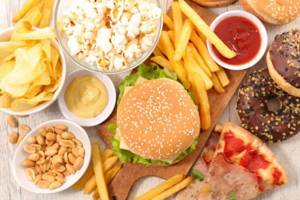
Nutritionist's comment:
Sometimes people, having learned about the dangers of hydrogenated fats, ask how to remove trans fats from the body? It is important to understand that trans isomers that are integrated into the cellular structure of organs - liver, brain or nervous tissue - cannot be replaced with the correct “building material”. But this does not matter, because the life of each cell is short, its place is soon taken by a new one. And if you consume products with beneficial components of the Omega-3 and Omega-6 groups, the functionality of the tissue will be restored. Switching to a healthy diet will stop the degradation of the epithelium.
How to protect yourself from eating unhealthy fatty foods
If you decide to change your lifestyle and at the same time improve your body shape, the first thing is to take control of your diet. The main changes in it are the rejection of fast carbohydrates and trans fats, as well as strict regulation of fatty foods. We offer simple rules:
- if you cannot completely eliminate foods with trans fats, at least reduce the proportion of this component to 1 g per day;
- do not fry meat and fish in oil, stew, grill, bake in its own juices;
- increase the proportion of fresh vegetables, fruits and berries in your diet, their consumption will reduce the craving for unhealthy snacks, which are widely offered in every cafeteria and supermarket;
- drink more clean water - this will help keep your hunger under control;
- exercise regularly - this will speed up your metabolism and, along with it, the process of cell division in organs and tissues.
Look at our Clients' Acknowledgments and Success Stories - View
Remember, trans fats are created only to improve the visual appeal of food and extend shelf life, and their presence does not improve the taste and nutritional characteristics. Specialists at Elena Morozova’s clinic will help you create a diet for you that will contain natural and harmless products and offer recommendations for a healthy lifestyle. This way you can guarantee proper nutrition and weight loss without harm to the body.
